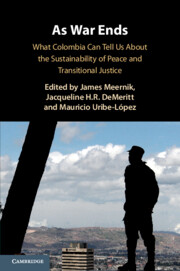Book contents
- As War Ends
- As War Ends
- Copyright page
- Contents
- Contributors
- Acknowledgments
- Introduction
- 1 The Complexity of the Organizational Design for Implementation of a Peace Accord
- 2 Violence, Grassroots Pressure, and Civil War Peace Processes
- 3 Land, Violence, and the Colombian Peace Process
- 4 Determinants of State Strength and Capacity
- 5 The Threat of Organized Crime in Post-Conflict Colombia
- 6 Violence after Peace
- 7 Two Emblematic Peacebuilding Initiatives in Antioquia
- 8 From Counterinsurgency to Peacebuilding
- 9 Transitional Justice in the Colombian Final Accord
- 10 The Comprehensive System of Truth, Justice, Reparation, and Non-Repetition
- 11 Una Tierra Inexplorada
- 12 Leading the Public to Peace
- 13 Securing the Peace and Promoting Human Rights in Post-Accord Colombia
- 14 Achieving an Unpopular Balance
- 15 Countering Violent Extremism through Narrative Intervention
- 16 Geographies of Truth in the Colombian Transitional Justice Process
- 17 Conclusion
- Index
- References
17 - Conclusion
Published online by Cambridge University Press: 18 July 2019
- As War Ends
- As War Ends
- Copyright page
- Contents
- Contributors
- Acknowledgments
- Introduction
- 1 The Complexity of the Organizational Design for Implementation of a Peace Accord
- 2 Violence, Grassroots Pressure, and Civil War Peace Processes
- 3 Land, Violence, and the Colombian Peace Process
- 4 Determinants of State Strength and Capacity
- 5 The Threat of Organized Crime in Post-Conflict Colombia
- 6 Violence after Peace
- 7 Two Emblematic Peacebuilding Initiatives in Antioquia
- 8 From Counterinsurgency to Peacebuilding
- 9 Transitional Justice in the Colombian Final Accord
- 10 The Comprehensive System of Truth, Justice, Reparation, and Non-Repetition
- 11 Una Tierra Inexplorada
- 12 Leading the Public to Peace
- 13 Securing the Peace and Promoting Human Rights in Post-Accord Colombia
- 14 Achieving an Unpopular Balance
- 15 Countering Violent Extremism through Narrative Intervention
- 16 Geographies of Truth in the Colombian Transitional Justice Process
- 17 Conclusion
- Index
- References
Summary
Colombia has embarked on one of the most complex and multifaceted efforts at building peace and delivering justice the world has ever seen. The sheer size and scope of the Colombian government’s agreement with the FARC guerrillas ensure the path will be neither easy nor short. In fact, there is more than one available path to peace and justice; those destinations may be accessed through a variety of new and novel trails, as well as well-worn roads. Some paths are narrow and difficult, while others “promise” a straight and wide transit to a brighter future. In this world of possibilities, the Colombian peace process offers no guarantees. The journeys are as diverse and difficult to traverse as Colombia’s geography. In this conclusion, we review the progress we have made in understanding how this journey will unfold, what challenges and opportunities may be waiting up ahead, and when and how the scholarly community can best explain how the future might look. More often than not, we must be content with posing the questions that we ought to pursue in the hope of finding these answers.
Information
- Type
- Chapter
- Information
- As War EndsWhat Colombia Can Tell Us About the Sustainability of Peace and Transitional Justice, pp. 392 - 410Publisher: Cambridge University PressPrint publication year: 2019
